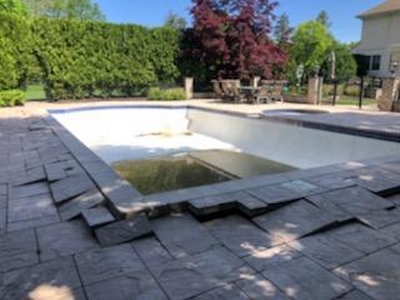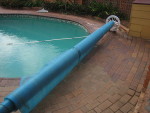The Incredible $300,000 Pop-up
A highly regarded pool company was going to give a swimming pool a light acid wash and repair a slight superficial crack in its surface. It turned into something considerably more.
Swimming Pool Inspection Services (SPIS) was contacted by its client, GFH Company to inspect and report on an in-ground swimming pool at a residential property in an exclusive neighborhood. The inspection was to confirm the cause of the pool’s damage and to estimate its repair or replacement cost. The claimant was the homeowner, Abby Ziegler. The insured party was AACA Pool Experts, a swimming pool maintenance and construction firm.
An online review of the pool company extolls their supposed expertise and competence:
“AACA Pool Experts has by far the most knowledgeable team in Virginia. [The owners] not only know more about pool and spa care and construction, but they also teach it to pool and spa professionals. They are experts at commercial pool installations, renovations, service, and operation. They hold every possible certification in the pool and spas industry and are considered the go-to guys when you need an answer to a difficult problem.”
Swimming Pool Inspection Services’ production manager conducted an interview with one of the owners of the company in late April.
Chuck stated that he felt so bad; this has never happened to him before. He explained that the pool was having a light acid wash when the damage occurred and he was also going to repair a slight superficial crack that was in the pool, but the pool was just left empty for too long. Chuck said that the pool was in excellent condition prior to the damage. Chuck said that his company builds pools, and in his opinion it would be better to rebuild the pool than to attempt a repair.
Swimming Pool Inspection Services’ inspector confirmed that hydrostatic pressure (pressure exerted by a liquid on adjacent bodies) caused the empty swimming pool to pop up out of the ground.
Our inspector noted that the pool and patio were fully renovated two years ago. He said the pool was an in-ground pool with a rectangular shape and had an attached spa. Prior to the damage, the interior tile and plaster were reported to be in very good condition and the pool equipment was functioning. The crack that was being inspected was superficial.
The insured’s area is known for its heavy clay soil. While the pool was left empty for three days, there was a heavy rainstorm that saturated the soil and greatly increased the hydrostatic pressure. The pool had a hydrostatic valve in the main drain and the pool repair company had drilled a two-inch hole through the shell.
Despite these precautions, the pool popped out of the ground about 6-10 inches. The skimmer, electrical components, diving board, safety cover, and plumbing were all damaged. The stone coping and the paver decking showed some damage in areas where the pool popped out of the ground.
Swimming Pool Inspection Services agreed with the owner of AACA Pool Experts that it would not be cost-effective to try to repair the pool—it would not be returned to its original condition—so our recommendation was a complete removal and replacement of the pool. The decking surrounding the pool, the plumbing and electrical, the diving board, and the safety cover all needed to be replaced. The final estimate of the cost to replace the pool came out to more than $300,000.
Commentary: Normally, when a swimming pool is full of water, it is weighed down, and hydrostatic pressure pushes against the walls and floor of the pool from the inside. At the same time, groundwater pushes against the exterior and underside of the pool—the hydrostatic pressure is balanced—the pool is stable. All pool professionals know this.
However, in this case, the pool repair company, preparing to give the pool a light acid wash and inspect a crack, drained the pool and left it empty for three days. This reduced the hydrostatic pressure from inside the pool, which would have been fine if the weather hadn’t changed. With the heavy rainstorm occurring while the pool was without water, and with high clay content making the surrounding soil especially absorbent, the ground around the pool became saturated and swelled up rapidly causing the hydrostatic pressure outside of the pool to increase. The imbalance caused the empty pool to pop up.
Although it’s rare for a pool to pop like this, draining a swimming pool is recommended to be done only during a period when there hasn’t been any rain and when no rain is in the forecast.
Takeaway: No matter what its reputation and technical expertise, a swimming pool repair company should check the local weather report before draining its customer’s pool.




Leave a Reply
Want to join the discussion?Feel free to contribute!